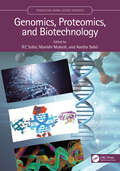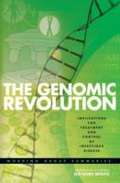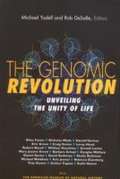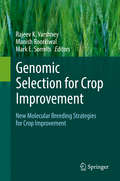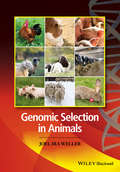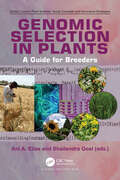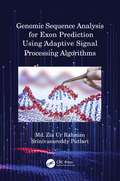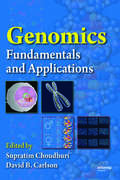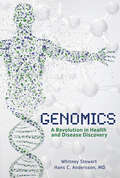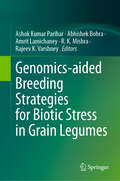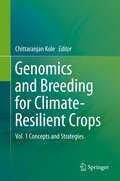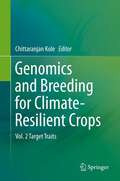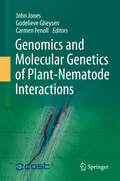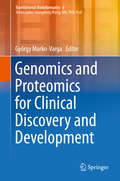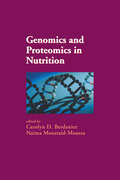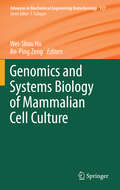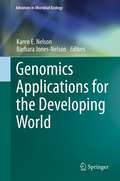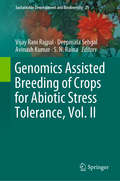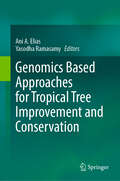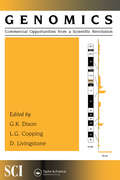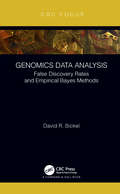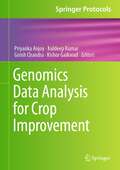- Table View
- List View
Genomic, Proteomics, and Biotechnology (Translating Animal Science Research)
by Rc Sobti Manishi Mukesh Aastha SobtiHigh-throughput molecular technologies ("omics") can help to decipher the contributions of different physiological systems and identify candidate molecules that are representative of different physiological pathways thereby allowing the discovery of biomarkers. Notably, the omics technologies along with and computational methods, bioprospecting, and artificial intelligence will continue to lead to better understanding of biological mechanisms that are responsible for physical attributes, or phenotypes. Research breakthroughs obtained through these technologies can be used to enhance productivity of food animals, meet the increasing demand for animal-sourced foods, enhance high-quality nutrient availability, ensure nutrient safety, mitigate the effects of climate variability, and result in new technologies that provide continued improvement in food security worldwide. Such breakthroughs are an urgent necessity because over the past 50 years, there has been an unprecedented increase in the world’s population, which will reach ten billion by the year 2050. Innovative and technological advancements that enhance all aspects of food production will arise from basic, fundamental research. Besides food, animal by-products have found many applications in the fields of pharmaceuticals, cosmetics, and household and industrial products. Hence, the need to ameliorate the productive, reproductive, growth performance, and disease resistance in animals has created a worldwide interest in gaining a deeper understanding of animal biology, biotechnology and genomics, and proteomics. The present volume thoroughly discusses the omics studies in domestic and non-domestic animals and their role in mitigation of various challenges ahead. The volume thus focusses on Omics (genomics, proteomics, transcriptomics, metabolonomics) technologies in identifying, characterizing biodiversity Role of molecular techniques for improvement of domestic and non-domestic organisms Animal and alternative model systems (using stem cells, tissue engineering, cell free systems, 3D platforms etc.) for studying life phenomena Genetically modified organisms as factories for the products
The Genomic Revolution: Implications For Treatment And Control Of Infectious Disease
by The National AcademiesThe 2005 conference, "The Genomic Revolution: Implications for Treatment and Control of Infectious Disease," attracted scientists, engineers, and medical researchers to work on new interdisciplinary responses using genomics to treat and control infectious diseases. Eleven conference working groups gave the participants eight hours to develop new research approaches to problems in infectious disease using genomics. Among the challenges were designing a new device to detect viral and bacterial pathogens; how best to use $100 million to prevent a future pandemic flu outbreak; how to improve rapid response to an outbreak of disease and reduce the cost of diagnostic tests; and how to sequence an individual's genome for under $1,000. Representatives from public and private funding organizations, government, industry, and the science media also participated in the working groups. This book provides a summary of the conference working groups. For more information about the conference, visit http://www.keckfutures.org/site/pageserver?pagename=past_genomics_conference_nov_2005www.keckfutures.org/genomics. The National Academies Keck Futures Initiative was launched in 2003 to stimulate new modes of scientific inquiry and break down the conceptual and institutional barriers to interdisciplinary research. The National Academies and the W.M. Keck Foundation believe considerable scientific progress and social benefit will be achieved by providing a counterbalance to the tendency to isolate research within academic fields. The Futures Initiative is designed to enable researchers from different disciplines to focus on new questions upon which they can base entirely new research, and to encourage better communication between scientists as well as between the scientific community and the public. Funded by a $40 million grant from the W.M. Keck Foundation, the National Academies Keck Futures Initiative is a 15-year effort to catalyze interdisciplinary inquiry and to enhance communication among researchers, funding agencies, universities, and the general public with the object of stimulating interdisciplinary research at the most exciting frontiers. The Futures Initiative builds on three pillars of vital and sustained research: interdisciplinary encounters that counterbalance specialization and isolation; the identification and exploration of new research topics; and communication that bridges languages, cultures, habits of thought, and institutions. Toward these goals, the National Academies Keck Futures Initiative incorporates three core activities each year: Futures conferences, Futures grants, and National Academies Communication Awards.
The Genomic Revolution: Unveiling The Unity Of Life
by Michael Yudell Rob DesalleFrom the discoveries of Watson and Crick to the appearance of Dolly the Sheep, the last fifty years have ushered in a revolution of knowledge in how organisms develop, function, and replicate. Scientists are now engaged in an epic task that will catapult the revolution to new heights: the sequencing of the human genome. Consider the scope of such a discovery. How different are we from one another? Does race have a scientific meaning? Is there such a thing as a disease gene? What are the potential risks of genetically modified food? Does a clone have a soul? The Human Genome Project will inevitably lead to landmark changes in medicine, agriculture, and the study of evolution--and will ultimately define the course of human history. The Genomic Revolution: Unveiling the Unity of Life takes readers on a fascinating journey through genomics--from the basic presentation of ideas about heredity through the essential principles of molecular biology, including an exploration of the ethical implications of the genome project for individuals and society. Some of the world's leading experts in genomics--Harold Varmus, Leroy Hood, Daniel Kevles, and Craig Venter, to name just a few--contribute their assessments of the state of current scientific research. Written for anyone wondering why we are the way we are, The Genomic Revolution is a timely and important collection that spans the science, the promise, and the potential pitfalls of a field moving so quickly that its achievements may alternately delight and trouble us, but almost always surprise us.
Genomic Selection for Crop Improvement
by Rajeev K. Varshney Manish Roorkiwal Mark E. SorrellsGenomic Selection for Crop Improvement serves as handbook for users by providing basic as well as advanced understandings of genomic selection. This useful review explains germplasm use, phenotyping evaluation, marker genotyping methods, and statistical models involved in genomic selection. It also includes examples of ongoing activities of genomic selection for crop improvement and efforts initiated to deploy the genomic selection in some important crops. In order to understand the potential of GS breeding, it is high time to bring complete information in the form of a book that can serve as a ready reference for geneticist and plant breeders.
Genomic Selection in Animals
by Joel WellerThe field of whole genome selection has quickly developed into the breeding methodology of the future. As efforts to map a wide variety of animal genomes have matured and full animal genomes are now available for many animal scientists and breeders are looking to apply these techniques to livestock production. Providing a comprehensive, forward-looking review of animal genomics, Genomic Selection in Animals provides coverage of genomic selection in a variety of economically important species including cattle, swine, and poultry. The historical foundations of genomic selection are followed by chapters that review and assess current techniques. The final chapter looks toward the future and what lies ahead for field as application of genomic selection becomes more widespread. A concise, useful summary of the field by one of the world's leading researchers, Genomic Selection in Animals fills an important gap in the literature of animal breeding and genomics.
Genomic Selection in Plants: A Guide for Breeders (Current Plant Science)
by Ani A. EliasGenomic selection (GS) is a promising tool in the field of breeding especially in the era where genomic data is becoming cheaper. The potential of this tool has not been realized due to its limited adaptation in various crops. Marker Assisted Selection (MAS) has been the method of choice for plant breeders while using the genomic information in the breeding pipeline. MAS, however, fails to capture vital minor gene effects while focusing only on the major genes, which is not ideal for breeding advancement especially for quantitative traits such as yield. The main aim of statistical methodologies coming under the umbrella of GS on using the whole genome information is to predict potential candidates for breeding advancement while optimizing the use of resources such as land, manpower, and most importantly time. Lack of proper understanding of the methods and their applications is one of the reasons why breeders shy away from this tool. The book is meant for biologists, especially breeders, and provides a comprehensive idea of the statistical methodologies used in GS, guidance on the choice of models, and design of datasets. The book also encourages the readers to adopt GS by demonstrating the current scenarios of these models in some of the important crops among oilseeds, vegetables, legumes, tuber crops, and cereals. For ease of implementation of GS, the book also provides hands-on scripts on GS data design and modeling in a popular open-source statistical program. Additionally, prospective in GS model development and thereby enhancement in crop improvement programs is discussed.
Genomic Sequence Analysis for Exon Prediction Using Adaptive Signal Processing Algorithms
by Md. Zia Rahman Srinivasareddy PutluriThis book addresses the issue of improving the accuracy in exon prediction in DNA sequences using various adaptive techniques based on different performance measures that are crucial in disease diagnosis and therapy. First, the authors present an overview of genomics engineering, structure of DNA sequence and its building blocks, genetic information flow in a cell, gene prediction along with its significance, and various types of gene prediction methods, followed by a review of literature starting with the biological background of genomic sequence analysis. Next, they cover various theoretical considerations of adaptive filtering techniques used for DNA analysis, with an introduction to adaptive filtering, properties of adaptive algorithms, and the need for development of adaptive exon predictors (AEPs) and structure of AEP used for DNA analysis. Then, they extend the approach of least mean squares (LMS) algorithm and its sign-based realizations with normalization factor for DNA analysis. They also present the normalized logarithmic-based realizations of least mean logarithmic squares (LMLS) and least logarithmic absolute difference (LLAD) adaptive algorithms that include normalized LMLS (NLMLS) algorithm, normalized LLAD (NLLAD) algorithm, and their signed variants. This book ends with an overview of the goals achieved and highlights the primary achievements using all proposed techniques. This book is intended to provide rigorous use of adaptive signal processing algorithms for genetic engineering, biomedical engineering, and bioinformatics and is useful for undergraduate and postgraduate students. This will also serve as a practical guide for Ph.D. students and researchers and will provide a number of research directions for further work. Features Presents an overview of genomics engineering, structure of DNA sequence and its building blocks, genetic information flow in a cell, gene prediction along with its significance, and various types of gene prediction methods Covers various theoretical considerations of adaptive filtering techniques used for DNA analysis, introduction to adaptive filtering, properties of adaptive algorithms, need for development of adaptive exon predictors (AEPs), and structure of AEP used for DNA analysis Extends the approach of LMS algorithm and its sign-based realizations with normalization factor for DNA analysis Presents the normalized logarithmic-based realizations of LMLS and LLAD adaptive algorithms that include normalized LMLS (NLMLS) algorithm, normalized LLAD (NLLAD) algorithm, and their signed variants Provides an overview of the goals achieved and highlights the primary achievements using all proposed techniques Dr. Md. Zia Ur Rahman is a professor in the Department of Electronics and Communication Engineering at Koneru Lakshmaiah Educational Foundation (K. L. University), Guntur, India. His current research interests include adaptive signal processing, biomedical signal processing, genetic engineering, medical imaging, array signal processing, medical telemetry, and nanophotonics. Dr. Srinivasareddy Putluri is currently a Software Engineer at Tata Consultancy Services Ltd., Hyderabad. He received his Ph.D. degree (Genomic Signal Processing using Adaptive Signal Processing algorithms) from the Department of Electronics and Communication Engineering at Koneru Lakshmaiah Educational Foundation (K. L. University), Guntur, India. His research interests include genomic signal processing and adaptive signal processing. He has published 15 research papers in various journals and proceedings. He is currently a reviewer of publishers like the IEEE Access and IGI.
Genomics: Fundamentals and Applications
by Supratim Choudhuri David B. CarlsonThis unique new text delivers a solid foundation for understanding the role of genomics in human health and in advances that promise to help improve the quality of human life. Unlike other works that focus mainly on toxicogenomic techniques, Genomics presents a thorough overview of the field in four major sections: 1) fundamentals of genes and geno
Genomics: A Revolution in Health and Disease Discovery
by Whitney Stewart Hans C. AnderssonOver the past 50 years, scientists have made incredible progress in the application of genetic research to human health care and disease treatment. Innovative tools and techniques, including gene therapy and CRISPR-Cas9 editing, can treat inherited disorders that were previously untreatable, or prevent them from happening in the first place. You can take a DNA test to learn where your ancestors are from. Police officers can use genetic evidence to identify criminals—or innocents. And some doctors are using new medical techniques for unprecedented procedures. Genomics: A Revolution in Health and Disease Discovery delves into the history, science, and ethics behind recent breakthroughs in genetic research. Authors Whitney Stewart and Hans Andersson, MD, present fascinating case studies that show how real people have benefitted from genetic research. Though the genome remains full of mysteries, researchers and doctors are working hard to uncover its secrets and find the best ways to treat patients and cure diseases. The discoveries to come will inform how we target disease treatment, how we understand our health, and how we define our very identities.
Genomics-aided Breeding Strategies for Biotic Stress in Grain Legumes
by Rajeev K. Varshney R. K. Mishra Abhishek Bohra Ashok Kumar Parihar Amrit LamichaneyThis contributed volume explores the latest breakthroughs in genetic and genomic resources for enhancing biotic stress responses in grain legumes – including minor ones. It covers the advances made to date, including gene identification, transcriptomics, proteomics, transgenics, genome editing, genomic selection, epigenetic breeding, and speed breeding related to different biotic stresses. Authored by crop-specific experts, the chapters in this book are essential resources for those directly involved in improving grain legume crops. Legumes play a vital role in ensuring food and nutritional security, enhancing soil quality, and promoting environmental sustainability. Rich in protein, they are essential in preventing hunger and malnutrition while adding to dietary diversity. However, as these crops are commonly grown in marginal lands with poor inputs, they are highly susceptible to biotic stresses such as diseases and pests, which can cause significant yield losses. This book consolidates all available knowledge about genetic and genomic aspects of biotic stress responses in various grain legumes. It is a must-have resource for all stakeholders involved in grain legume improvement. Whether you are a breeder, pathologist, biotechnologist, seed production specialist, market manager, graduate or post-graduate student, or any other industry professional, this book serves as an excellent guide to help you stay at the forefront of grain legume improvement.
Genomics and Bioinformatics
by Tore SamuelssonWith the arrival of genomics and genome sequencing projects, biology has been transformed into an incredibly data-rich science. The vast amount of information generated has made computational analysis critical and has increased demand for skilled bioinformaticians. Designed for biologists without previous programming experience, this textbook provides a hands-on introduction to Unix, Perl and other tools used in sequence bioinformatics. Relevant biological topics are used throughout the book and are combined with practical bioinformatics examples, leading students through the process from biological problem to computational solution. All of the Perl scripts, sequence and database files used in the book are available for download at the accompanying website, allowing the reader to easily follow each example using their own computer. Programming examples are kept at an introductory level, avoiding complex mathematics that students often find daunting. The book demonstrates that even simple programs can provide powerful solutions to many complex bioinformatics problems.
Genomics and Breeding for Climate-Resilient Crops
by Chittaranjan KoleClimate change is expected to have a drastic impact on agronomic conditions including temperature, precipitation, soil nutrients, and the incidence of disease pests, to name a few. To face this looming threat, significant progress in developing new breeding strategies has been made over the last few decades. The first volume of Genomics and Breeding for Climate-Resilient Crops presents the basic concepts and strategies for developing climate-resilient crop varieties. Topics covered include: conservation, evaluation and utilization of biodiversity; identification of traits, genes and crops of the future; genomic and molecular tools; genetic engineering; participatory and evolutionary breeding; bioinformatics tools to support breeding; funding and networking support; and intellectual property, regulatory issues, social and political dimensions.
Genomics and Breeding for Climate-Resilient Crops: Vol. 2 Target Traits
by Chittaranjan KoleClimate change is expected to have a drastic impact on agronomic conditions including temperature, precipitation, soil nutrients, and the incidence of disease pests, to name a few. To face this looming threat, significant progress in developing new breeding strategies has been made over the last few decades. The second volume of Genomics and Breeding for Climate-Resilient Crops describes various genomic and breeding approaches for the genetic improvement of the major target traits. Topics covered include: flowering time; root traits; cold, heat and drought tolerance; water use efficiency; flooding and submergence tolerance; disease and insect resistance; nutrient use efficiency; nitrogen fixation; carbon sequestration; and greenhouse gas emissions.
Genomics and Molecular Genetics of Plant-Nematode Interactions
by Carmen Fenoll Godelieve Gheysen John JonesThis book reviews developments in the molecular biology of plant-nematode interactions that have been driven by the application of genomics tools. The book will be of interest to postgraduate students and to researchers with an interest in plant nematology and/or plant pathology more generally. A series of introductory chapters provide a biological context for the detailed reviews of all areas of plant-nematode interactions that follow and ensure that the bulk of the book is accessible to the non-specialist. A final section aims to show how these fundamental studies have provided outputs of practical relevance.
Genomics and Proteomics for Clinical Discovery and Development
by György Marko-VargaThe book is intended to be a resource for students as well as scientists in education and for the general public to learn about proteomics and genomics. Chromosomes form the basis for our genetic heritage and are the code for protein synthesis. The Human Genome Map came out in 2002, and the Proteome Sequence Map is under currently being created by a global consortia initiative. Proteome and genome building blocks already form the basis of scientific research areas as well as large parts of the pharmaceutical and biomedical industry. The book initiative will provide the background to and our current understanding of these gene and protein areas, as well as describe how cutting-edge science is using these resources to develop new medicines and new diagnostics for patient care and treatment. The book will be useful for undergraduate students as well as university students and researchers who need a good understanding of genomics and proteomics within the clinical field. The book will also be targeted at a broad public as well as readers not specialized within this field. Dr. Marko-Varga is the head of the Head of Div. Clinical Protein Science & Imaging at the Biomedical Center, Dept. of Measurement Technology and Industrial Electrical Engineering, Lund University, and Professor at the 1st Department of Surgery, Tokyo Medical University, Tokyo, Japan.
Genomics and Proteomics in Nutrition
by Carolyn D. Berdanier Naima Moustaid-MoussaWith contributions from 66 world-renowned authorities on the subject, Genomics And Proteomics In Nutrition focuses on the effect of genetic expression on protein production, establishing links between gene expression and nutrition, the influence of micro- and macronutrients on cellular homeostasis, and the relationship between diet, genetic
Genomics and Systems Biology of Mammalian Cell Culture
by Wei Shou Hu An-Ping ZengTranscriptome Analysis, by Frank Stahl, Bernd Hitzmann, Kai Mutz, Daniel Landgrebe, Miriam Lübbecke, Cornelia Kasper, Johanna Walter und Thomas Scheper Transcriptome Data Analysis for Cell Culture Processes, by Marlene Castro-Melchor, Huong Le und Wei-Shou Hu Modeling Metabolic Networks for Mammalian Cell Systems: General Considerations, Modeling Strategies, and Available Tools, by Ziomara P. Gerdtzen Metabolic Flux Analysis in Systems Biology of Mammalian Cells, by Jens Niklas und Elmar Heinzle Advancing Biopharmaceutical Process Development by System-Level Data Analysis and Integration of Omics Data, by Jochen Schaub, Christoph Clemens, Hitto Kaufmann und Torsten W. Schulz Protein Glycosylation and Its Impact on Biotechnology, by Markus Berger, Matthias Kaup und Véronique Blanchard Protein Glycosylation Control in Mammalian Cell Culture: Past Precedents and Contemporary Prospects, by Patrick Hossler Modeling of Intracellular Transport and Compartmentation, by Uwe Jandt und An-Ping Zeng Genetic Aspects of Cell Line Development from a Synthetic Biology Perspective, by L. Botezatu, S. Sievers, L. Gama-Norton, R. Schucht, H. Hauser und D. Wirth.
Genomics Applications for the Developing World
by Barbara Jones-Nelson Karen E. NelsonThis book evolved from the editors strong belief that the information and new developments that were evolving from the rapidly growing field of genomics and that are happening primarily in the developed world have not happened at a parallel rate in the developing world. One would have hoped that by now the technologies and approaches would have been adapted on a far greater scale. In addition to this, the associated information is not always easily accessible, and is not disseminated in a format that can become a useful reference for scientists, students and others who reside in developing countries.
Genomics Assisted Breeding of Crops for Abiotic Stress Tolerance, Vol. II (Sustainable Development and Biodiversity #21)
by Vijay Rani Rajpal Deepmala Sehgal Avinash Kumar S. N. RainaThe abiotic stresses like drought, temperature, cold, salinity, heavy metals etc. affect a great deal on the yield performance of the agricultural crops. To cope up with these challenges, plant breeding programs world-wide are focussing on the development of stress tolerant varieties in all crop species. Significant genomic advances have been made for abiotic stress tolerance in various crop species in terms of availability of molecular markers, QTL mapping, genome-wide association studies (GWAS), genomic selection (GS) strategies, and transcriptome profiling. The broad-range of articles involving genomics and breeding approaches deepens our existing knowledge about complex traits. The chapters are written by authorities in their respective fields. This book provides comprehensive and consolidated account on the applications of the most recent findings and the progress made in genomics assisted breeding for tolerance to abiotic stresses in many important major crop species with a focus on applications of modern strategies for sustainable agriculture. The book is especially intended for students, molecular breeders and scientists working on the genomics-assisted genetic improvement of crop species for abiotic stress tolerance.
Genomics Based Approaches for Tropical Tree Improvement and Conservation
by Ani A. Elias Yasodha RamasamyThis book offers foundational knowledge to advance genomic approaches in forest tree improvement and genetic resource conservation. The tropical tree breeding sector has fallen behind in genomic breeding not due to a lack of resources but rather a limited understanding and an underdeveloped genomic breeding pipeline. While marker-assisted selection (MAS) has been the preferred method for incorporating genomic data into breeding programs, it primarily targets major genes, overlooking minor gene effects. This limitation makes MAS less effective for enhancing quantitative traits such as heartwood content. The primary goal of statistical methodologies using whole-genome information is to predict promising candidates for breeding advancement/commercialization while efficiently managing resources such as land, labor, and, most critically, time. Given the long rotation period of forest tree crops, the ability to identify, select, and modify genotypes with high heritability for economically valuable traits within a shorter timeframe marks a significant advancement in breeding. This book provides comprehensive guidelines on leveraging genomic data, including pathogenomics, to breed resilient, future-ready trees and manage populations effectively. To reinforce these guidelines, the book presents case studies on species such as Tectona grandis, Santalum album, Casuarina, Shorea, Artocarpus, tropical and sub-tropical pines, and tropical fruit trees. Additionally, the book explores broader applications of genetic data, including timber tracing and the conservation of germplasm while minimizing genetic redundancy. This book will be a valuable resource for tropical tree breeders and researchers, equipping them with the methods and tools needed to adopt advanced genomic breeding. Additionally, students and scholars will benefit from the comprehensive information it provides, enhancing their understanding of modern breeding techniques.
Genomics: commercial opportunities from a scientific revolution
by G. K. Dixon L. G. Copping D. LivingstoneThis title covers topical and unexplored issues relating to the commercial outcome of the genetic revolution which will be of great interest to both academia and industry. The book discusses whether the availability of genome sequence information will yie
Genomics Data Analysis: False Discovery Rates and Empirical Bayes Methods
by David R. BickelStatisticians have met the need to test hundreds or thousands of genomics hypotheses simultaneously with novel empirical Bayes methods that combine advantages of traditional Bayesian and frequentist statistics. Techniques for estimating the local false discovery rate assign probabilities of differential gene expression, genetic association, etc. without requiring subjective prior distributions. This book brings these methods to scientists while keeping the mathematics at an elementary level. Readers will learn the fundamental concepts behind local false discovery rates, preparing them to analyze their own genomics data and to critically evaluate published genomics research.Key Features:* dice games and exercises, including one using interactive software, for teaching the concepts in the classroom* examples focusing on gene expression and on genetic association data and briefly covering metabolomics data and proteomics data* gradual introduction to the mathematical equations needed* how to choose between different methods of multiple hypothesis testing* how to convert the output of genomics hypothesis testing software to estimates of local false discovery rates* guidance through the minefield of current criticisms of p values* material on non-Bayesian prior p values and posterior p values not previously published
Genomics Data Analysis for Crop Improvement (Springer Protocols Handbooks)
by Priyanka Anjoy Kuldeep Kumar Girish Chandra Kishor GaikwadThis book addresses complex problems associated with crop improvement programs, using a wide range of programming solutions, for genomics data handling and sustainable agriculture. It describes important concepts in genomics data analysis and sequence-based mapping approaches along with references. The book contains 16 chapters on recent developments in several methods of genomic data analysis for crop improvements and sustainable agriculture, all authored by eminent researchers who are experts in their fields. These chapters focus on applications of a wide range of key bioinformatics topics, including assembly, annotation, and visualization of next-generation sequencing (NGS) data; expression profiles of coding and noncoding RNA; statistical and quantitative genetics; trait-based association analysis, quantitative trait loci (QTL) mapping, and artificial intelligence in genomic studies. Real examples and case studies in the book will come in handy when applying the techniques. The relative scarcity of reference materials covering bioinformatics applications as compared with the readily available books also enhances the utility of this book. The targeted readers of the book are scientists, researchers, and bioinformaticians from genomics and advanced breeding in different areas. The book will appeal to the applied researchers engaged in crop improvements and sustainable agriculture by using bioinformatics tools, students, research project leaders, and practitioners from the various marginal disciplines and interdisciplinary research.
Genomics-Enabled Learning Health Care Systems: Workshop Summary
by Sarah H. BeachyThe inclusion of genomic data in a knowledge-generating health care system infrastructure is one promising way to harness the full potential of that information to provide better patient care. In such a system, clinical practice and research influence each other with the goal of improving the efficiency and effectiveness of disease prevention, diagnosis, and treatment. To examine pragmatic approaches to incorporating genomics in learning health care systems, the Institute of Medicine Roundtable on Translating Genomic-Based Research for Health hosted a workshop which convened a variety of stakeholder groups, including commercial developers, health information technology professionals, clinical providers, academic researchers, patient groups, and government and health system representatives, to present their perspectives and participate in discussions on maximizing the value that can be obtained from genomic information. The workshop examined how a variety of systems are capturing and making use of genomic data to generate knowledge for advancing health care in the 21st century. It also sought to evaluate the challenges, opportunities, and best practices for capturing or using genomic information in knowledge-generating health care systems. "Genomics-Enabled Learning Health Care Systems" summarizes the presentations and discussion of the workshop.
Genomics-Enabled Learning Health Care Systems: Workshop Summary
by Sarah H. BeachyThe inclusion of genomic data in a knowledge-generating health care system infrastructure is one promising way to harness the full potential of that information to provide better patient care. In such a system, clinical practice and research influence each other with the goal of improving the efficiency and effectiveness of disease prevention, diagnosis, and treatment. To examine pragmatic approaches to incorporating genomics in learning health care systems, the Institute of Medicine Roundtable on Translating Genomic-Based Research for Health hosted a workshop which convened a variety of stakeholder groups, including commercial developers, health information technology professionals, clinical providers, academic researchers, patient groups, and government and health system representatives, to present their perspectives and participate in discussions on maximizing the value that can be obtained from genomic information. The workshop examined how a variety of systems are capturing and making use of genomic data to generate knowledge for advancing health care in the 21st century. It also sought to evaluate the challenges, opportunities, and best practices for capturing or using genomic information in knowledge-generating health care systems. Genomics-Enabled Learning Health Care Systems summarizes the presentations and discussion of the workshop.
